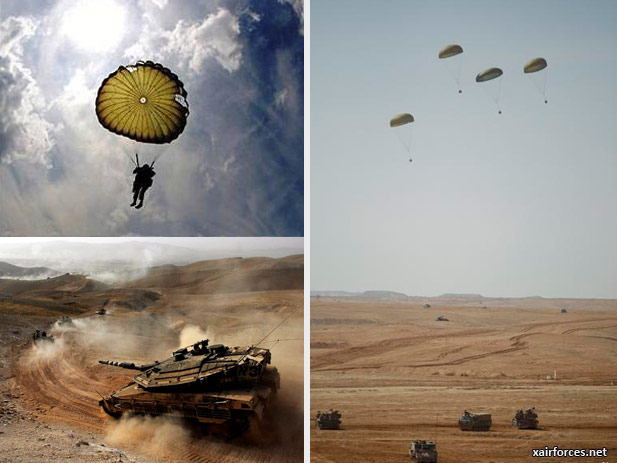
Israeli paras prep for airborne strikes

The Israeli military has conducted its first full-scale parachute exercise for its airborne brigade in 15 years as part of military preparations for "any possible scenario" and "potential regional changes," including long-range assaults.
Amid the tensions sweeping the Middle East, and the possibility of a war involving Israel against Iran and Syria plus their allies Hezbollah and Hamas, that suggests the Israelis could be thinking of using paratroopers to hit key targets, such as missile launch sites and depots, inside hostile territory.
At least 1,000 paratroopers took part in the drop in the Jan. 17 Negev Desert in southern Israel, the army said.
"We're restoring a capability that we once had," the airborne brigade commander, Col. Amir Baram, declared ahead of the mass jump from U.S.-built C-130 Hercules transport aircraft.
"We can't know what will happen in the changing Middle East and every Western military which respects itself needs to know how to parachute large forces, bring them together and then launch an attack."
The last time the paratroop brigade had a full-strength training drop was in 1997.
The last time the brigade went into combat in force by air was in the 1956 Sinai Campaign against Egypt, when paratroopers seized the Mitla Pass on the western side of the peninsula ahead of ground forces.
Israel's military commanders fear that in the event of a major new conflict, possibly triggered by the worsening confrontation between Iran and the West in the Persian Gulf, the Jewish state will come under an unprecedented and sustained missile and rocket bombardment that could last for weeks, with potentially calamitous consequences.
Underlining the urgency of military preparations to deal with this onslaught, the mass parachute drop was conducted at night, giving weight to the supposition that a surprise air assault by hundreds of elite troops may be under consideration.
As things stand now, a major attack on Israel would largely be conducted at long range, and would be primarily countered by Israel's strategic missile forces, the air force and even the navy's missile-firing submarines.
The army and its armored divisions of Merkava Mark-4 battle tanks would play little role -- except for elite Special Forces units operating behind the lines to target missile sites and storage depots -- and paratroopers.
The most probable targets for airborne forces would be Hezbollah's fortified missile depots in the Bekaa Valley in northeastern Lebanon along the border with Syria.
The Israel military believes the Shiite movement, supported by Iran and its Arab ally Syria, possesses more than 42,000 missiles and rockets.
Hundreds of these are deemed capable of hitting anywhere inside the Jewish state, including all major cities and towns as well as strategic targets such as air bases.
Iran is believed to have in excess of 150 Shehab-3b ballistic missiles, while Syria has hundreds of Soviet-designed Scuds, M600s and other weapons able to hit Israel.
The Israeli army has frequently carried out airborne raids using relatively small commando forces transported in helicopters over the years. But to concentrate a sizeable force, such as the airborne brigade, in one place at one time would involve large, and unwieldy, numbers of helicopters.
One possible target for a mass combat jump would be in the Sinai Peninsula, which Israeli strategists view as a danger since Egyptian authorities lost control of the desert zone following the February 2011 overthrow of President Hosni Mubarak.
Islamist organizations now operate there without much hindrance from Cairo, still convulsed by political turbulence nearly a year after Mubarak's downfall.
Israelis fear that if the new powers in Cairo seek to scrap or significantly amend the historic 1979 peace treaty with Egypt, Sinai could again become a combat zone 32 years after it was demilitarized.
Last week's brigade-size paratroop exercise underlines how the Israeli military is scrambling to adjust to the new realities in the Middle East, where long-suppressed Islamist parties are winning overwhelming support in landmark elections and alarming Israeli leaders.
In December, the Israeli military formed a new formation known as the Deep Corps which combines all Special Forces units under one command for secret operations to be conducted in hostile territory.
The paratroop brigade's exercise dovetails neatly into the new special operations offensive concept the military is honing to hit Israel's enemies on their own turf.
Source: Tel Aviv, Israel, 25 January 2012 - Special Reports / United Press International News (www.upi.com)
Photo: The Israeli military parachute exercise (Photo by http://nosint.blogspot.com)
(25.01.2012)
|